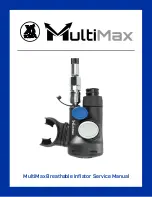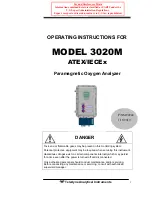
INTRODUCTION
The HD8706-R2 is a portable instrument which
measures conductivity, TDS (total dissolved solids) and
temperature.
The measuring ranges of the instrument are 0…200mS for
conductivity, 0…99.9ppm, 0…99.9ppt for TDS measurement, -
50…+199.9°C for temperature (The measure can be limited by
the measuring range of the probe: please verify the ranges).
The TDS conversion factor can change from a minimum value
of 0.4 to a maximum of 0.8 and it can be set by the program.
The instrument is provided with standard serial port RS232C.
The temperature and conductivity or TDS measurements
can be transmitted, in real time, to a PC or to a printer fitted
with serial port. The sampling interval can be selected by the
program between the values 1, 5, 10, 30 seconds, 1, 5 or 10
minutes.
The HD8706-R2 can be connected to the PC and the software
DeltaLog1
(version 1.5 and following ones) allows to dis-
play and download the data.
APPLICATIONS
•
checking water for agricultural use;
•
checking water for industrial cooling;
•
checking distilled water;
•
checking drinking water, from rivers and wells;
•
checking water for fish breeding;
•
conductivity measurement of:
- Chemical effluents
- Waste effluents
- Demineralizers
- Inverse osmosis
- Steam boilers
- Condensate recovery
- Boiler drain outlets
- Cooling towers
- Desalination plants
- Salinity
- Analysis laboratories
- Oceanography- TDS (total dissolved solids)
- TDS (total dissolved solids)
The conductivity is the property of a substance has of con-
ducting electric current. The inverse of the conductivity is the
resistivity. All substances have conductivity; This varies a great
deal depending on the nature of the substances, ranging from
very low values such as those for glass to very high values
such as metals in general. Liquids are generally made up
of ionic compounds dissolved in water, their conductivity is
between that of insulating materials and metals. The basic
unit for measuring resistance is the ohm; the reciprocal of
resistance is conductivity. The basic unit of conductivity is the
SIEMENS/cm, with submultiples mS/cm and µS/cm and the
conductivity between two opposite faces of a one-centimetre
cube of material.
EFFECTS OF TEMPERATURE
In aquoeus solutions the conduction process is due to ionic
movement, the behaviour is totally different from the behaviour
of metals. Conductivity increases as the temperature rises,
which is the opposite of what happens in metals, but similar
to what happens in graphite. The conduction phenomenon is
influenced by the nature of the ions and by the viscosity of
the liquid. All these processes depend on the temperature
and, as a result, the conductivity substantially depends on the
temperature and is expressed as a relative variation per °C at a
particular temperature: normally with percentages/°C at 20°C.
Conductivity data are normalized at a temperature of 20°C
or 25°C.
The measurement of a solution at a temperature
of 20°C or 25°C is declared indipendently of the liquid
temperature.
TECHNICAL DATA HD8706-R2
Measuring ranges/resolutions of the instrument:
Resolution
CONDUCTIVITY (Kcell=1):
0...199.9µS 0.1µS
1999µS
1µS
19.99mS
0.01mS
199.9mS
0.1mS
TDS (
χ
/TDS =0.5):
0...99.9ppm 0.1ppm
999ppm
1ppm
9.99ppt
0.01ppt
99.9ppt
0.1ppt
TEMPERATURE:
0...+90°C (+32...+194°F) with built-in sensor
in the conductivity cell SPT06;
-50...+199,9°C (-58...392°F) with optional TP 870;
resolution 0,1°C or 0,1°F.
PRECISION:
±0,5% f.s. ±0,5% of rdg for conductivity and TDS;
±0,2°C (±0,4°F) ±0,3% of rdg for temperature (probe
error included).
TEMPERATURE COMPENSATION:
automatic in the range
0…100°C with
α
T
= 0,00...4,00%/°C.
REFERENCE TEMPERATURE:
settable
20°C or 25°C.
χ
/TDS CONVERSION FACTOR:
settable in the range
0.4…0.8.
DISPLAY:
LCD 12 mm.
SYMBOLS ON THE DISPLAY:
HOLD, RCD, REL, MAX, MIN,
°C, °F, µS, mS, A(=ppm), B(=ppt).
A/D CONVERSION FREQUENCY:
about 1 sec.
FUNCTIONS:
Autorange, HOLD, storage of RCD, MAX/MIN,
relative measurements, automatic and/or manual calibra-
tion with acknowledgement of the two standards 1413
μ
S
e 12.88mS, TDS measurement with conversion factor
from 0.4 to 0.8, data downloading to the serial port.
INSTRUMENT WORKING TEMPERATURE:
0...+50°C
(+32...+122°F).
SPT06 PROBE WORKING TEMPERATURE:
0...+90°C.
POWER SUPPLY:
9V/IEC6LF22 battery, lifetime of about 100
hours with alcaline battery. Low battery charge indicated
by the message “BAT” on the display and by a “Beep” a
intervals of 5 seconds.
WEIGHT:
about 280 gr.
DIMENSIONS:
215 x 73 x 38 mm.
PROBE CONNECTION:
DIN 45326 8 pole connector.
CONDUCTIVITY OF VARIOUS AQUEOUS SOLUTIONS AT 25°C
CONDUCTIVITY
Pure water (H
2
0)
0.055 µS/cm
Distilled water
0.5 µS/cm
Water circulating in boilers
1.0 µS/cm
Pure mountain stream water
1.0 µS/cm
Drinking water for towns
50 µS/cm
0.01Mol KCI Sol (Standard)
1.413 µS/cm
Maximum for drinking water
1.055 µS/cm
10% NaOH
355 mS/cm
10% H
2
SO
4
432 mS/cm
31.0% HNO
3
(known maximum)
865 mS/cm
CONCEPT OF THE CELL CONSTANT
A cell for measuring conductivity may be made up as shown
in the drawing C, it is made of insulating material except for
the opposite faces A and B which are made of metal. If it is
filled with a conductivity solution L, the conductance measured
between the faces A and B is the following:
G = LA/
l
where
G = conductance in Siemens
L = Conductivity in Siemens/cm
l
= distance in cm between the electrodes or faces A and B
A = surface in cm
2
perpendicular to the flow of current.
The corresponding equation for the resistance is:
R =
l
/A
where
R = resistance in ohm
ρ
= resistivity in ohm/cm
l
= distance in cm between the electrodes
A = surface in cm
2
perpendicular to the flow of current.
The term
l
/A is defined as K
c
, the
cell constant
of resistivity,
and its measuring unit is the cm
-1
.
The cell constant of the resistivity is used for all the applica-
tions, irrespective of whether conductivity or resistivity is being
used: the result is
G=L/K
c
or K
c
xG=L
As the dimensions of the cell change, the cell constant varies
with the ratio
l
/A
.
The standards to which reference is made for measuring
conductivity are solutions with a base of potassium chloride
(KCl). According to ASTM D1125-82 standards, the data are
as follows:
CONDUCTIVITY µS/cm at 25°C
0.001
146,93
0.01
1.408,8
0.1
12.856,0
1.0
111.342,00


























